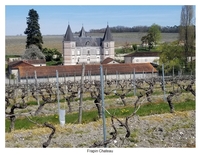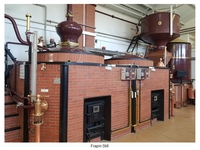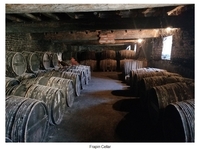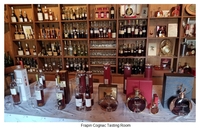COGNAC, France — Here in this mysterious land known officially as Charente or Charente-Maritime, roughly an hour’s drive north of Bordeaux, the rolling hills are covered with hundreds of thousands of acres of vines that produce wine no one will ever drink.

The primary grapes planted in the region — Ugni Blanc, Folle Blanche and Colombard — yield wines that are typically thin and acidic and generally unfit for human consumption. They’re perfect for the production of cognac, the epitome of grape brandy and one of the world’s most refined and sophisticated spirits.
 The tradition of cognac goes back hundreds of years. All cognac must be twice distilled in copper stills and aged for at least two years in French oak, either from Limousin or Troncais. The finest, most expensive and rare cognacs are aged for decades before blending, and they command thousands of dollars per bottle.
The tradition of cognac goes back hundreds of years. All cognac must be twice distilled in copper stills and aged for at least two years in French oak, either from Limousin or Troncais. The finest, most expensive and rare cognacs are aged for decades before blending, and they command thousands of dollars per bottle. On this visit, I checked in on Cognac Frapin, one of the oldest houses in the region, situated in the village of Segonzac. The Frapin family traces its winemaking roots back 21 generations, to 1270, and owns almost 600 acres under vine in the coveted Grande Champagne district. The Cognac region is subdivided into several cru, but the two most important are Grande Champagne and Petite Champagne, not in any way to be confused with the sparkling-wine producing Champagne region northeast of Paris.
On this visit, I checked in on Cognac Frapin, one of the oldest houses in the region, situated in the village of Segonzac. The Frapin family traces its winemaking roots back 21 generations, to 1270, and owns almost 600 acres under vine in the coveted Grande Champagne district. The Cognac region is subdivided into several cru, but the two most important are Grande Champagne and Petite Champagne, not in any way to be confused with the sparkling-wine producing Champagne region northeast of Paris. Frapin is widely distributed throughout the United States and produces a broad range of cognac products to suit every taste and budget. A unique feature of Frapin cognacs is that in virtually every age category, the average age exceeds the minimum age.
Frapin is widely distributed throughout the United States and produces a broad range of cognac products to suit every taste and budget. A unique feature of Frapin cognacs is that in virtually every age category, the average age exceeds the minimum age.Here is the lineup:
Frapin 1270 is the family’s entry-level Cognac and is often used in cocktails, or simply served over ice, a common practice in the region. Notes of apple, vanilla and spice are characteristic of this product. The average time in the bottle is four years, the equivalent of a VSOP ("very superior old pale"), although it has been marketed as a VS ("very special"). Rating: 89.
The Frapin VSOP Premier Cru de Cognac boasts an average age of six years. The additional time in barrel lends richness and heft, a strong hint of stone fruits, a floral note and exceptional depth. Serve it neat or over ice. Rating: 92.
The Frapin Cigar Blend Premier Cru de Cognac is a blend that averages 10 years of age, and it shows. It’s rich and spicy with complex aromas of stone fruits. Rating: 94.
The Frapin Chateau Fontpinot is an exquisite XO made from entirely estate-grown grapes and aged 20 years in barrel. Aromas of white flowers and spice on the nose lead to a complex palate of rich dried fruits. The spirit has been aged in dry cellars that tend to concentrate flavors and aromas more quickly. Rating: 97.
The Frapin XO VIP has been aged in humid cellars and has an average age of 25 years. It exhibits exotic notes of orange peel and spice, a floral back note and a remarkably smooth, suave palate. Rating: 98.
Frapin Extra is an otherworldly spirit with an average age of 40-45 years in barrel. It shows notes of violets and spice; exceptional length; complex aromas of orange peel and vanilla; and a freshness that belies its age. The price tag is a bit hefty, running $600 to $700, but the experience is priceless. Rating: 100.
Frapin Plume goes for about $3,000 a bottle, and it’s easy to understand. The average age is 60 years in barrel. Remarkably refined and suave, Plume (that’s the symbol of the Frapin family) offers subtle notes of candied fruits, spice and mint in a mesmerizing combination of flavors and aromas. Rating: 100.
Frapin also produces the occasional vintage Cognac. Armagnac, another exceptional spirit produced in southwest France, has long made vintage bottlings, but it is somewhat rare in Cognac.
"Sometimes in Cognac there is a miracle," said Alain Royer, Frapin’s ambassador to the United States. "The wine ages in a perfect way and it deserves a vintage."
There are two vintages, 1988 and 1991, that are currently available in the U.S. The 1988 is extremely intense and shows upfront notes of spice and orange peel. The 1991 is smooth and spicy with a floral note and a stronger essence of stone fruits. It is rounder and softer than the 1988, but each is inviting and satisfying in its own way.
Read more columns at: Robert Whitley
Follow Robert on Twitter at @wineguru.
